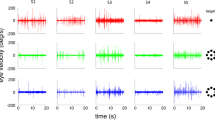Abstract
Fixation is the link between the physical environment and the visual observer, both of which can be dynamic. That is, dynamic fixation serves the task of preserving a reference point in the world, despite relative motion. In this respect, fixation is dynamical in two senses: in response to voluntary changes of fixation point or attentive cues-gaze shiftings, and in response to the desire to compensate for the retinal slip-gaze holding.
The work presented here, addresses the vergence movement and preservation of binocular fixation during smooth pursuit. This movement is a crucial component of fixation. The two vergence processes, disparity vergence and accommodative vergence, are described; a novel algorithm for robust disparity vergence and an active approach for blur detection and depth from defocus are presented. The main characteristics of the disparity vergence technique are the simplicity of the algorithm, the influence of both left and right images in the course of fixation and the agreement with the fixation model of primates. The major characteristic of the suggested algorithm for blur detection is its active approach which makes it suitable for achieving qualitative and reasonable depth estimations without unrealistic assumptions about the structures in the images.
The paper also covers the integration of the two processes disparity vergence and accommodation vergence which are in turn accomplished by an integration of the disparity and blur stimuli. This integration is accounted for in both static and dynamic experiments.
Similar content being viewed by others
References
Abbott, A.L. and Ahuja, N. 1988. Surface reconstruction by dynamic integration of focus, camera vergence and stereo. Proc. 2nd ICCV, Tampa, FL., pp. 532–543.
Alpern M. and Ellen P. 1956. A quantitative analysis of the horizontal movements of the eyes in the experiment of Johannes Müller. American Journal of Ophthalmology, 42:289–303
Alpern M. 1957. The position of the eyes during prism vergence. American Journal of Ophthalmology, 57:345–353.
Calway, A.D., Knutsson, H., and Wilson, r. 1992. Multiresolution estimation of 2-D disparity using frequency domain approach. Proc. BMVC, pp. 237–246.
Carpenter R.H.S. 1988. Movements of the Eyes, Pion press: London.
Clark, J.J. and Ferrier, N.J. 1988. Modal control of an attentive vision system. Proc. 2nd ICCV, Tampa, FL., pp. 514–523.
Coombs, D.J. 1992. Real-time gaze holding in binocular robot vision. Ph.D. Thesis, University of Rochester.
Fry G.A. 1937. An experimental analysis of the accommodation-convergence relationship. American Journal of Optometry, 14:402–414.
Fry G.A. 1939. Further experiments on the accommodation-convergence relationship. American Journal of Optometry, 16:325–336.
Horii A. 1992. The focusing mechanism in the KTH head-eye system. TRITA-NA-P9215, Royal Institute of Technology, Computational Vision and Active Perception Laboratory, Stockholm.
Horii A. 1992. Depth from defocusing. TRITA-NA-P16, Royal Institute of Technology, Computational Vision and Active Perception Laboratory, Stockholm.
Horn, B.K.P. 1989. Robot Vision, The MIT Press, p. 25.
Jarvis R.A. 1976. Focus optimisation criteria for computer image processing. Microscope, 24(2):163–180.
Jepson, A.D. and Jenkin, M.R.M. 1989. The fast computation of disparity from phase differences. Proc. CVPR, pp. 398–403.
Julesz, B. 1971. Foundations of cyclopean perception. University of Chicago Press.
Knoll H.A. 1949. Pupillary changes associated with accommodation and convergence. American Journal of Optometry, 26:346–357.
Krotkov, E.P. 1989. Active Computer Vision by Cooperative Focus and Stereo, Springer Verlag, 1989.
Luneburg R.K. 1948. Mathematical Analysis of Binocular Vision, Princeton University Press: Princeton.
Maddox E.E. 1886. Investigations in the relation between convergence and the accommodation of the eyes. Journal of Anatomy, 20:475–568.
Maki, A., Uhlin, T., and Eklundh, J.-O. 1993. Phase-based disparity estimating in binocular tracking. Proc. 8th Scandinavian conf. on Image Analysis, Tromsø, Norway.
Marg E. and Morgan M.W. 1949. The pupillary near reflex. The relation of pupillary diameter to accommodation and the various components of convergence. American Journal of Optometry, 26:183–198.
Marg E. and Morgan M.W. 1949. Further investigation of the pupillary near reflex; the effect of accommodation, fusional convergence and the proximity factor on pupillary diameter. American Journal of Optometry, 27:217–225.
Müller J. 1826. Zur Vergleichenden Physiologie des Gesichtssinnes, C. Conbloch, Leipzig.
Pahlavan, K., Uhlin, T., and Eklundh, J.-O. 1992. Integrating Primary Ocular Processes. Proc. 2nd ECCV, Santa Margherita Ligure, Italy, pp. 526–541.
Pahlavan, K. and Eklundh, J.-O. 1992. A head-eye system-analysis and design. CVGIP: Image Understanding, Special Issue on Active Vision, Y. Aloimonos (ed.) 56(1):41–56.
Pahlavan K., Uhlin T., and Eklundh J.-O. 1993. Active vision as a methodology. Active Vision, Y. Aloimonos (ed.). Advances in Computer Science, Lawrence Erlbaum, Hillsdale, NJ, pp. 19–46.
Pahlavan, K. 1993. Active robot vision and primary ocular processes. Ph.D. Thesis, TRITA-NA-P9316, Royal Institute of Technology, Computational Vision and Active Perception Laboratory, Stockholm.
Pahlavan, K. and Eklundh, J.-O. 1994. Mechatronics of active vision. Mechatronics, Elsevier Science, pp. 113–123.
Pentland, A. 1987. A new sense for depth of field. Proc. IEEE Trans. PAMI, pp. 523–531.
Pentland, A., Darrell, T., Turk, M., and Huang, W. 1989. A simple real-time range camera. Proc. CVPR, pp. 256–261.
Sanger T.D. 1988. Stereo disparity computation using Gabor filters. Biological Cybernetics, 59:405–418.
Subbarao, M. 1988. Parallel depth recovery by changing camera parameters. Proc. 2nd ICCV, pp. 149–155.
Tenenbaum, J.M. 1970. Accommodation in Computer Vision, Ph.D. Thesis, Stanford University.
Yarbus A. 1967. Eye Movements and Vision, Plenum Press: New York.
Zhang, W. and Bergholm, F. 1993. An extension of Marr's “Signature” based edge classification and other methods determining diffuseness and height of edges, and bar edge width. Proc. 4th ICCV, Berlin, pp. 183–191.
Author information
Authors and Affiliations
Rights and permissions
About this article
Cite this article
Van Pahla, K., Uhlin, T. & Eklundh, JO. Dynamic fixation and active perception. Int J Comput Vision 17, 113–135 (1996). https://doi.org/10.1007/BF00058748
Issue Date:
DOI: https://doi.org/10.1007/BF00058748




